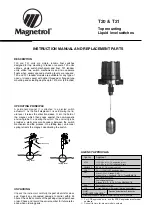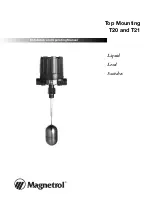
IB01602019E
For more information visit: www.eaton.com
Instructional Booklet
Effective: March 2010
Page
3
O&M Manual for the Eaton ATC-100
Automatic Transfer Switch Controller
•
Complies with Comité Internationale Spécial des Perturbations
Radioelectrotechnique (CISPR) 11, Class B
•
Complies with Federal Communications Commission (FCC) Part
15, Class B
•
Meets European Standards Conformance (CE mark)
The ATC-100 provides an unmatched degree of programmed flex-
ibility to address the needs of any system. It operates from sys-
tem voltages between 120 and 480 Vac, single-phase or 3-phase,
at 50 or 60 Hz. In addition, a period of no control power opera-
tion is provided. The ATC-100 monitors the condition of the
3-phase line-to-line voltage and frequency of both the utility and
generator power sources. It can also be set up for single-phase
operation. The ATC-100 provides the necessary intelligence to
insure that the transfer switch operates properly through a series
of programmed sensing and timing functions.
A standard ATC-100 will:
•
Monitor utility and generator power source voltages and genera-
tor power source frequency
•
Provide undervoltage protection of the utility and generator
power sources
•
Provide underfrequency and overfrequency protection of the
generator power source
•
Permit easy customer set up
•
Permit system testing
•
Provide faceplate source status indications
1.4 Glossary
With respect to their use within this document and as they relate
to ATS and controller operation, the following terminology is
defined.
Available
A source is defined as “available” when it is within its undervolt-
age / underfrequency/overfrequency (if applicable) set-point
ranges for the nominal voltage and frequency setting.
Connected
Connected is defined as when the input is shorted by an external
contact or connection.
Failed or Fails
A source is defined as “failed” when it is outside of the applicable
voltage and frequency set-point ranges for the nominal voltage
and frequency setting for a time exceeding 0.5 seconds after the
time delay emergency fail (TDEF) time delays expires.
Failsafe
Failsafe is a feature that prevents disconnection from the only
available power source and also forces a transfer or re-transfer
operation to the only available power source.
Re-Transfer
Re-transfer is defined as a change of the load connection from the
generator to the utility.
Utility
Utility is the primary source (normal source, normal power source,
or normal).
Generator
Generator is the secondary source (emergency source, emergency
power source, emergency, standby, or backup source).
Utility: Failed or Fails
Utility is defined as “failed” when it is outside of its undervoltage
set-point range for the nominal voltage setting.
Generator: Failed or Fails
Generator is defined as “failed” when it is outside of its undervolt-
age/ underfrequency/overfrequency (if applicable) set-point ranges
for the nominal voltage and frequency setting for a time exceeding
0.5 seconds after the TDEF time delay expires.
Switching Device
A switching device is used to change available power sources to a
common load. (i.e. circuit breaker, molded case switch, power
contactor)
Transfer
Transfer is defined as a change of the load connection from the
utility to the generator power source.
Unconnected
Unconnected is defined as when the input is not shorted by an
external contact or connection.
VIN, RMS
Refers to the operating input voltage (Vac, RMS).
1.5 Functions/Features/Options
The primary function of ATC-100 is to accurately monitor power
sources and provide the necessary intelligence to operate an ATS
in an appropriate and timely manner. In addition, the ATC-100
provides status information through the device’s faceplate.
1.5.1 Operational Simplicity
From installation to programming to usage, the ATC-100 was
designed with operational simplicity in mind. Only one style needs
to be considered, regardless of input/output requirements or sys-
tem voltages and frequencies. The ATC-100 provides the func-
tionality of numerous other devices combined in one package that
mounts in 6.5 by 8.5 in. (165.1 by 215.9 mm) of panel space.
1.5.2 Features
The following is a list of the features of the ATC-100.
1. Time Delay Normal to Emergency (TDNE)
This feature provides a time delay when transferring from the
utility source to the generator power source. Timing begins
when the generator source becomes available. It permits con-
trolled transfer of the load circuit to the generator source.
Jumper selectable at 2 or 15 seconds.
2. Time Delay on Engine Starting (TDES)
This feature provides a time delay of the signal to initiate the
engine/generator start cycle in order to override momentary
power outages or voltage fluctuations of the utility source.
Fixed setting of three seconds
3. Time Delay Emergency to Normal (TDEN)
This feature provides a time delay of the re-transfer operation
to permit stabilization of the utility source. Timing begins
when the utility source becomes available. If the generator
source fails during timing, then a re-transfer is immediate,
overriding the time delay.
Fixed setting of five minutes.
4. Time Delay for Engine Cool-down (TDEC)
This feature provides a time delay of the signal to initiate the
engine/generator stop cycle after the re-transfer operation.
This allows the engine/generator to cool down by running
unloaded. Timing begins on completion of the re-transfer
cycle.
Fixed setting of five minutes.




































